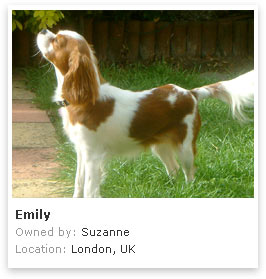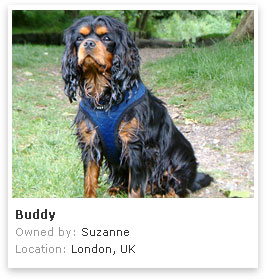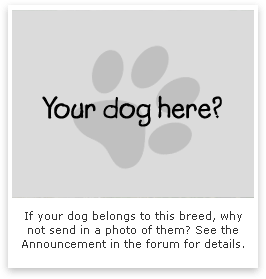OriginIt is believed that the original progenitors of the breed which came to be known as the Cavalier King Charles Spaniel were dogs from China, Japan and Tibet which arrived in Europe more than a thousand years ago with travellers and traders. Over centuries, and through various crossings, a type known as the Toy Spaniel emerged and from the 16th century found great and continuing popularity in the households of British royalty and nobility. These small dogs were particular favourites of King Charles II for whom they were named. With the passage of time came changes to the breed - muzzles getting shorter, skulls becoming rounder, and a general diminution in size. In 1926 an American, Rosewell Eldridge, was disappointed to find little resemblance in the modern King Charles Spaniel to those depicted in the Old Master paintings of Charles II’s era. Consequently he offered a prize at Crufts for dogs closest in appearance to the originals. Some breeders undertook the task which led to the recognition in the 1940s of two distinct breeds: the King Charles Spaniel and the re-created Cavalier King Charles Spaniel which now far exceeds the former in numbers.
Character:The Cavalier King Charles Spaniel is, deservedly, one of the most popular of all breeds of dog in the U.K. He is renowned for his sweet disposition and his devotion to his owners. His greatest pleasure in life is to be close to those he loves and he must be regarded as an indoor dog to be included as a valued member of the family. If relegated to a lonely life with little human company and interaction he will fail to thrive, becoming sad and withdrawn instead of the lively out-going dog he should be. His lovely temperament is evident in his willingness to be a friend to everyone he meets. This trusting, affable nature means that he is not exactly guard-dog material. He will bark to announce visitors but thereafter will go forward to meet and greet with a gaily wagging tail and a happy smile. With children he is generally very good and will join in their games with great enjoyment. Despite his small stature and ‘cuddlesomeness’ the Cavalier is a dog and should be respected as such. He needs and deserves the same training in household rules and acceptable behaviour as any other dog if he is to fulfil his potential as a pleasant companion. Beware however those heart-melting eyes brimming with love - many good intentions have drowned in those large, dark pools. The Cavalier is also a sturdy and robust fellow who, although he loves his comforts, is quite happy to poke around after elusive rabbits and get wet, muddy and adorned with twigs and other debris in the process. Adaptable to living in town or country, mansion or apartment, with a family or individual, with young or elderly, the charming Cavalier King Charles Spaniel has proved himself to be the ideal dog for almost anyone, anywhere.
Exercise:This breed does not require a vast amount of exercise but daily walks and games at home are recommended to prevent the CKCS becoming overweight and lazy. He will enjoy getting out and about to meet people and walks will also provide him with interesting sights and scents to keep his mind stimulated and boredom at bay. If a safe area can be found for off-lead exercise he will delight in running around and playing energetic games. Some Cavaliers retain a fair amount of their ancestors’ sporting traits so care must be taken lest the sight or scent of potential quarry trigger his hunting instinct and he disappears in joyful pursuit.
Training:The CKCS is a very intelligent dog and this, combined with his willingness to please his beloved owner, means that he is not difficult to train in basic obedience requirements. Training should start as early as possible and only positive methods which reward wanted behaviours with food treats and praise should be used. Harsh methods which involve rough handling and loud reprimands will bewilder this trusting little dog causing him anguish and eroding the bonds of affection and respect which are fundamental to successful training. The Cavalier’s responsiveness and eagerness to oblige his handler make him an excellent competitor in obedience trials. He is also readily trained as a therapy dog and in that role he brings happiness and comfort to many outside his family circle. Socialization should commence in early puppyhood. This is the process of accustoming the pup to as many as possible of the sights, sounds, people, animals, situations, that he may encounter during his lifetime. The well-trained and adequately socialized dog will have the skills necessary to cope with the world in a calm, confident, courteous manner and will be an admirable representative of his breed.
|
KC Group:
Toy
KC, AKC, FCI recognized?
Yes
Size:
Small
Height:
30 - 33 cm (12 - 13 ins)
Weight:
5.4 - 8.2 kg (12 - 18 lbs)
Colour:
Black and tan, Ruby, Tricolour, Blenheim
Lifespan:
9 - 14 years
Coat:
Long, silky, not curly, may be slightly waved
Grooming:
Moderate
Health issues:
Mitral valve disease (MVD), syringomyelia (SM), patella luxation, autoimmune thrombocytopoenia, hip dysplasia, eye problems, hypothyroidism, epilepsy, brachycephalic syndrome

|











